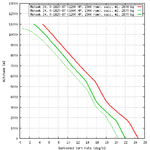Hi Vincenzo,
>HoHun can you recheck P-36A graphs? (maybe best take out R-1830 variant graphs for R-1820 variant)
Hm, I think the Mohawk IV would be the best choice, but I don't have good data on the R-1820-G205A it used.
Here is some basic data, but it doesn't give full throttle heights or power at full throttle heights:
Reference
What is the propeller diameter of the Mohawk IV? 9' 9" like for some earlier variants?
Regards,
Henning (HoHun)
>HoHun can you recheck P-36A graphs? (maybe best take out R-1830 variant graphs for R-1820 variant)
Hm, I think the Mohawk IV would be the best choice, but I don't have good data on the R-1820-G205A it used.
Here is some basic data, but it doesn't give full throttle heights or power at full throttle heights:
Reference
What is the propeller diameter of the Mohawk IV? 9' 9" like for some earlier variants?
Regards,
Henning (HoHun)



